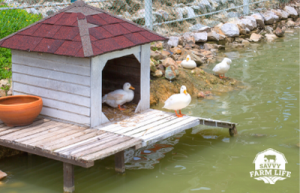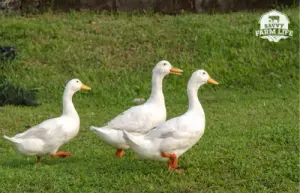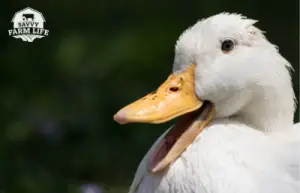How Much It Costs To Own a Duck
Ducks can be a fantastic addition to a small family farm. They are cute, come in a variety of colors and sizes, and get along with most other farm animals. But just like with any other addition to your farm, you have to ask the question, how much does it cost to own a duck?
From initial purchase through lifelong care, it costs as little as $50 per year to own a duck. However, ducks are social animals who must have a flock, so you can’t just keep one duck. In addition to the base costs of owning a duck, there are also one-time start-up costs and monthly and yearly recurring expenses.
By the end of this article, you’ll have the information you need to decide whether ducks are a good choice for you, how many you should purchase, and what kind!
Factors That Impact the Cost of Owning a Duck 
There are many factors to consider when budgeting for your duck flock, including what breed of duck is best for your primary objective, one-time expenses such as building the brooder and pen, and some recurring expenses for things like feed and vet care.
Duck Breeds
The most important factor to decide on first is the breed of duck based on what purpose you want them to serve. Just like with chickens and cows, some duck breeds have been developed to produce more meat than others, while some are more efficient at producing eggs. And some have been bred to be more mild-mannered and are ideal for homesteads with children.
Additionally, some breeds that are most desirable for certain qualities can be more challenging to come by and therefore also more expensive.
Best Duck Breeds for Meat
The number one duck for meat is the heavy-bodied Pekin. They are one of the largest duck species and therefore produce the most meat per animal. They also grow very fast, are so common that they are quite inexpensive, and mix well with other ducks.
Moulard ducks, the sterile hybrid offspring of a Pekin female and Muscovy male often referred to as “mule ducks,” are a very close second to the Pekin. They are similar in size and their meat actually tastes better. These are harder to come by, however, since they’re a sterile hybrid species unable to breed. They may produce some eggs, but of course those won’t ever hatch.
Muscovy duck meat has about half as much surface fat as Pekin meat and again, a better flavor. Their meat is considered to be the leanest and therefore healthiest of duck meats, but they are poor egg layers. One plus side to these ducks besides their unique coloration is that they don’t quack. The most they can do is hiss, making them a good meat duck choice if you live near neighbors who don’t appreciate farm animal sounds.
Rouen ducks, commonly mistaken for mallards because of their coloring, produce a tasty, more fattening meat. They’re slightly smaller than Muscovies, but quite a bit larger than mallards. They lay a decent amount of eggs, but not quite enough to make them an excellent dual-purpose choice.
Best Duck Breeds for Eggs
Indian Runner Ducks are one of the top four most efficient egg producers. And they have their own unique look about them, too. Originally bred in Malaysia and China, these unusually up-right ducks were used to weed rice fields. They were considered “herding ducks” and were directed throughout the fields to eat the undesired plants.
These athletic ducks tend to lay 250+ eggs per year.
Khaki Campbell Layers are even more prolific than Indian Runners. This breed was originally refined by an English woman named Mrs. Campbell, who wanted a duck that could be an efficient layer as well as a good piece of meat since her family particularly enjoyed eating duck.
These khaki-colored ducks continue to be one of the most popular breeds for egg laying with their 300+ eggs per year production history.
Welsh Harlequin Layers were produced by selective breeding of Khaki Campbell individuals with a lighter, more attractive color pattern. The Welsh were the most successful with this endeavor, hence their name. While they are beautiful to look at, their ancestors didn’t bring extreme production efficiency with them into the line.
To enjoy the aesthetic of this breed, you’ll have to sacrifice several dozen eggs per year as these ducks only put out about 240 eggs on a yearly basis.
Hybrid Egg Layers are produced from a variety of different egg-laying breeds. The benefit of hybrids, like mixed-breed dogs, is that any negative tendencies within a certain breed can be diluted by adding the genetics of another breed. If both breeds have the same positive traits, such as prolific egg production, then the result will be a genetically diverse bird less prone to breed-specific health issues and equal or increased prolificity than its parents.
The most popular breed combinations are called the White Star Hybrid Layer and the Gold Star Hybrid Layer. Gold stars lay around 220-240 eggs per year, and white stars lay as much as 290.
Best Duck Breeds for Temperament
Buff Orpington ducks make the top four for duck breeds with friendly temperament and also bring their beautiful, pale-golden plumage to recommend them. They are good layers and have medium-sized bodies, making them decent meat ducks as well. Additionally, while they may be able to lift their feet a couple of inches off the ground for a few moments, they can’t truly fly. So you don’t have to worry about choosing between clipped wings or golden escapees.
Cayuga ducks possess an even more unique plumage in addition to their calm demeanor. They look black in general, but in the sun their feathers display gorgeous iridescent green and purple hues. These ducks are also one of the most soft-spoken breeds, making them a good choice for farmers with neighbors close by. They are also only medium-sized, but still too large to fly. The only downside to these is that they can be much more challenging to find and more expensive.
Rouen ducks, the meat breed mentioned above that look like large mallards, are a wonderful combination of pretty mallard colors and too-big-to-fly-away size. Their easy temperament makes them a good addition to a chill flock.
Pekin ducks once again come in at the top for a category. These ducks are one of the largest-bodied ducks, and they grow the fastest and are incredibly easy to find. They are friendly and get along well with other breeds. One downside to these is that they are one of the loudest ducks you can find, andd they sport plain white plumage.
Best Duck Breeds for All Three Traits
With all these different traits in mind, the Pekin comes in at the top for all three. With its excellent temperament, unbeatable size, and relatively high egg production rate of 250+ eggs per year, it’s an obvious choice if these are your top priorities for choosing a duck breed.
They are quite loud, however, and plain-looking.
Rouen ducks come in at a close second just because of their slightly smaller bodies and lower egg-production rates. But they are mild-mannered and beautiful.
In third place for desirable trait combinations, we have the buff orpington duck. While they only produce around 200 eggs per year, they are big-bodied and have gorgeous pale-gold plumage.
The cost for each of these breeds falls between $8 and $9 per duckling.
One-time Duck Owning Expenses
Cost of Purchasing the Ducks/Ducklings 
The cost for individual ducklings ranges from about $5-$10 each, depending on the breed. All ducks mentioned in this article fall within that range. But you can’t just get away with buying one duckling. Ducks are social animals with an ingrained need for a flock. They need at least a handful of friends.
Unfortunately, when purchasing very young animals, there is always a chance that one or two of them will die shortly after purchase, whether due to the stress of transportation or some invisible health problem. If you only purchase two or three ducklings, there is a chance that you could end up with only one before long. And ducks don’t do well alone. They will either wither away from loneliness or find another flock to join.
Ducklings also can’t be easily sexed at such a young age, so you don’t know how many males or females you’ll end up with. Male ducks can become very aggressive, so you may need to use extra males for meat soon after they reach adulthood, or you may need to find them another home, further reducing your flock.
With all that in mind, it’s best to purchase several ducklings in the beginning.
Purchasing/Building a Brooder for Ducks
Young ducklings aren’t yet able to maintain their body temperature, so they require a heat source. Even if you plan to start them out inside your house or garage, they will need additional heat to survive. You’ll need a container to house them in with a hot side and a cool side so that they can move back and forth as needed to maintain a comfortable body temperature. A heat light should be added to the warm side to keep it around 90-95 degrees.
You can DIY this entire setup for as little as $25 dollars to cover the heat lamp and bulb. Use cardboard boxes for the containers and replace them as the ducklings get them wet and dirty. Most large stores throw away tons of boxes on a daily basis and will give you a bunch for free if you ask. Use newspapers or paper towels for bedding and cut down old cool whip or butter containers for food and water bowls.
This inexpensive setup will require a little more effort on your part to maintain, but it is extremely affordable.
If money is no object and time-saving is more important to you, you can purchase a high-end, all-inclusive, low-maintenance brooder kit for $300-$400. This is also a great option if you plan to frequently raise ducklings as you can reuse everything rather than acquiring new materials on a regular basis. These kits include everything from the thermostatically regulated brooding container to the feeders, waterers, and bedding.
Long-Term Duck Husbandry Cost
If you can get your hands on some spare timber lying around or some free pallets, you can construct a duck shelter for around $20 in screws and a tin roof.
For adult duck feeders and waterers, you can go as cheap as rubber bowls for around $15 each. If your ducks are allowed to forage in the yard, you won’t need the food bowl in the summer, only in the winter when food is scarce.
If you want to reduce food waste as much as possible, you can go for the more expensive poultry bucket feeder, which costs about $65. This will help prevent some of the messiness ducks are prone to and will make it harder for rats and mice to steal your ducks’ food.
As for waterers, the region of the world you live in must be factored into your choice. Kiddie pools are great for small flocks and can be purchased for $10-20. If you live in a place that stays above freezing all year, this could be all you need.
But if temperatures drop below 32 degrees Fahrenheit in your area, you’ll need a heated pool for your ducks. Ducks need access to more than just a water bowl, and they need it all year round. Without the ability to submerge their heads, they become susceptible to respiratory infections from food clogging up their nostrils. Thanks to their messy nature, they must be able to clean themselves up at all times.
Purchasing a poultry tub or pan that pairs well with a submersible de-icer will cost you about $80-$100.
Adult ducks will also need a pen to safely run around in. Even if they are free-roam during the day, it’s best to keep them contained and safe at night.
100 feet of 4-foot-high fencing can be purchased on Amazon for about $30. This will keep the ducks contained and prevent some predation, but won’t keep out raccoons or weasels. An electric fence is a more thorough option, but the voltage needed to keep larger predators away could be dangerous to ducks. So you’d need to have an additional, smaller fence within the electric one to keep the ducks from accidentally touching it.
All of the items required for 100 feet of electric fencing will cost between $100 and $300 dollars.
Recurring Duck Expenses
Duck Feed Cost 
The cheapest duck feed on Amazon is 40 lbs for $62. That comes to $1.55/lb. Check with your local feed store to see if there are cheaper local options. Some feed stores offer 50 lb bags for as little as $16, which comes to $0.32/lb.
One adult duck will eat approximately 2 lbs of food per week, which comes to a little over 8 lbs per duck per month. So for a flock of six ducks, you’ll go through about 1 50-lb bag per month.
Nesting Materials
Ducks require straw for nesting, just like wild birds. $3-$10 will buy you a bale of hay to last many ducks the whole year.
Miscellaneous Duck Expenses to Consider
Vet Expenses
With the proper environment, diet, and protection from predators, most ducks will hopefully never need to visit the vet. But for wounds, bumblefoot (sores that can progress to abscesses on the feet), or diarrhea, a veterinarian’s intervention is required.
Few vets are qualified to see ducks. An exam will likely cost $50-$75, and treatment for the problem could be anywhere from $20 to several hundred. It wouldn’t hurt to keep a little side savings for potential medical needs for your flock.
You now have all the information you need to choose the best duck breeds and the best style of duck housing for your budget and needs. We wish you the best as you go duck shopping and brooder building!
Save this article to your “Duck Care” board on Pinterest!
